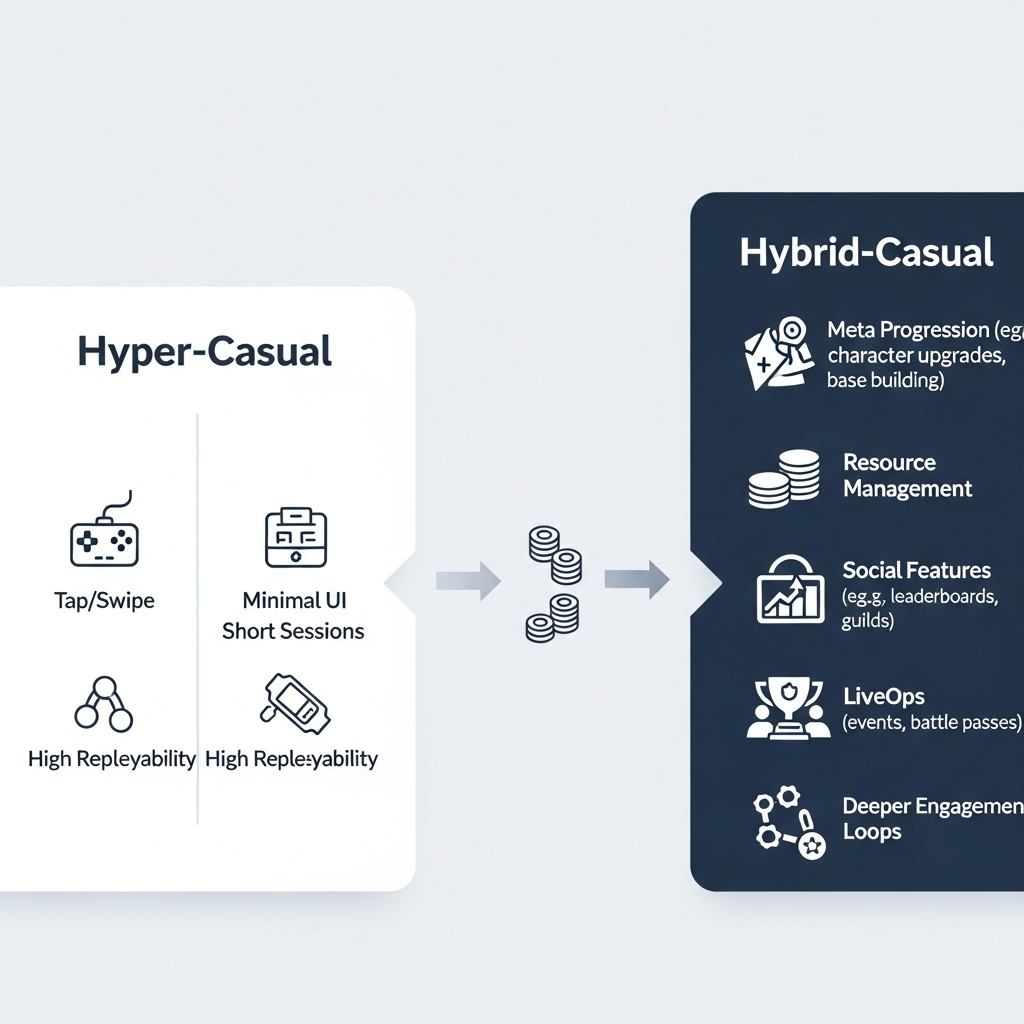The mobile gaming landscape is witnessing a fundamental shift as hybrid-casual games emerge to address the limitations of hyper-casual titles while maintaining their accessibility. This evolution represents more than a simple genre iteration; it’s a sophisticated response to changing player expectations, market saturation, and the economic realities of mobile game development in 2025.
Understanding the Hyper-Casual Foundation
Hyper-casual games dominated mobile gaming from 2017 to 2023 with their instantly understandable mechanics, minimalist aesthetics, and aggressive user acquisition strategies. These games typically featured single-tap controls, 30-second gameplay loops, and monetization primarily through advertising. Titles like Helix Jump and Roof Rails exemplified the genre’s focus on immediate accessibility over depth.
The hyper-casual model’s success stemmed from its alignment with mobile user behavior patterns. Short session lengths fit perfectly into micro-moments throughout the day—waiting in lines, commercial breaks, bathroom visits. The lack of tutorials or complex progression systems meant players could engage instantly without cognitive investment. This frictionless entry created massive audiences, with successful titles achieving millions of downloads within weeks of launch.
However, the hyper-casual model’s weaknesses became increasingly apparent. Player retention rates typically plummeted after day one, with less than 10% of players returning after a week. Low lifetime values meant profitability depended entirely on massive scale and efficient user acquisition. As advertising costs increased and the market became saturated with similar titles, the pure hyper-casual model became economically challenging for all but the largest publishers.
The Hybrid-Casual Innovation
Hybrid-casual games retain hyper-casual’s accessibility while adding meta-game layers that significantly improve retention and monetization. These titles feature intuitive core mechanics that anyone can grasp immediately, but layer on progression systems, collection elements, and social features that give players reasons to return. The result is games that cast wide nets for user acquisition while maintaining engaged player bases for months rather than days.
The meta-progression systems in hybrid-casual games provide long-term goals without overwhelming casual players. Character upgrades, base building, or collection mechanics create sense of advancement beyond high scores. These systems are designed to be ignorable for players seeking quick sessions while providing depth for those wanting deeper engagement. This dual-track design philosophy enables hybrid-casual games to serve multiple player segments simultaneously.
Monetization in hybrid-casual games balances advertising revenue with in-app purchases more effectively than pure hyper-casual titles. While ads remain important, especially for non-paying users, the addition of meaningful progression creates opportunities for monetization through battle passes, cosmetic items, and convenience purchases. This diversified revenue model reduces dependence on advertising rates while increasing average revenue per user.
Core Design Principles
Successful hybrid-casual games maintain hyper-casual’s “easy to learn, hard to master” philosophy while adding strategic depth. The core gameplay loop remains simple enough for anyone to understand within seconds, but mastery requires understanding of deeper systems. Archero exemplifies this approach with its simple one-finger control scheme hiding complex build strategies and enemy pattern recognition.
The progression pacing in hybrid-casual games is carefully calibrated to maintain engagement without frustrating casual players. Early progression is rapid and rewarding, hooking players with frequent dopamine hits. The pace gradually slows, introducing soft paywalls that can be overcome through skilled play or patience. This pacing respects both paying and non-paying players while creating monetization opportunities.
Session length flexibility distinguishes hybrid-casual from both hyper-casual and mid-core games. Players can engage for 30-second sessions or 30-minute sessions depending on their available time and interest. Short sessions might involve completing a single level, while longer sessions could include managing upgrades, participating in events, or competing in tournaments. This flexibility maximizes the addressable audience and daily engagement opportunities.
Monetization Evolution and Strategy
The advertising strategy in hybrid-casual games is more sophisticated than the interstitial-heavy approach of hyper-casual titles. Rewarded video ads are integrated meaningfully into gameplay, offering valuable rewards that enhance rather than interrupt the experience. Players voluntarily watch ads for extra lives, currency multipliers, or special items, creating positive associations with advertising content.
In-app purchase design in hybrid-casual games focuses on value and convenience rather than pay-to-win mechanics. Battle passes provide predictable spending opportunities with clear value propositions. Starter packs offer compelling one-time purchases for converting non-payers. Remove ads options cater to players who enjoy the game but dislike advertising. This respectful monetization builds long-term player relationships rather than extracting maximum value quickly.
The economic model of hybrid-casual games enables sustainable development practices. Higher lifetime values justify greater investment in content updates and live operations. Regular events, seasonal content, and feature additions keep games fresh for retained players while providing marketing hooks for re-engagement campaigns. This ongoing development creates virtuous cycles where investment in content drives retention, which justifies further investment.
Social and Competitive Elements
Social features in hybrid-casual games are designed to enhance rather than dominate the experience. Asynchronous competition through leaderboards and tournaments provides competitive elements without requiring real-time multiplayer infrastructure. Ghost racing, where players compete against recordings of other players, creates multiplayer feel without synchronization complexity.
Clan or team systems create community bonds that significantly improve retention. Players feel obligation to contribute to team goals, creating social pressure for regular play. These systems are designed to be optional and non-punitive, allowing solo players to enjoy games without feeling excluded. The social layer adds depth for engaged players while remaining invisible to those preferring solitary experiences.
Collaborative events bring communities together around shared goals. Server-wide challenges where all players contribute to unlocking rewards create sense of shared accomplishment. These events provide natural marketing moments and re-engagement opportunities while fostering positive community sentiment.
Technical Architecture and Performance
Hybrid-casual games require more sophisticated technical architecture than hyper-casual titles while maintaining broad device compatibility. Progressive loading ensures games start quickly despite additional content. Core gameplay loads first, with meta-systems loading in background. This approach maintains the instant playability of hyper-casual while supporting deeper features.
Cloud save synchronization becomes essential as players invest more time in progression. Robust backend systems ensure progress is never lost while enabling cross-device play. These systems must handle millions of concurrent users efficiently while preventing cheating and exploitation. The technical infrastructure investment required for hybrid-casual games is significantly higher than hyper-casual but justified by improved monetization.
Performance optimization across diverse hardware is crucial for maintaining the broad appeal of casual games. Adaptive quality settings automatically adjust graphics and effects based on device capabilities. Low-end devices receive simplified visuals ensuring smooth gameplay, while high-end devices showcase enhanced graphics that aid marketing and user acquisition.
Content Strategy and Live Operations
Content pacing in hybrid-casual games requires careful balance between providing enough new content to maintain engagement without overwhelming casual players. Weekly events offer fresh challenges for engaged players. Monthly content updates add new levels, features, or progression systems. Seasonal themes provide variety and marketing opportunities. This regular cadence creates anticipation and habits that improve retention.
A/B testing becomes crucial for optimizing hybrid-casual games’ complex systems. Every aspect from difficulty curves to monetization offers can be tested and optimized. Machine learning algorithms analyze player behavior to personalize experiences, adjusting difficulty, ad frequency, and offer timing based on individual player patterns. This data-driven approach maximizes both player satisfaction and revenue generation.
Community management takes on greater importance as players invest more deeply in hybrid-casual games. Social media engagement, community feedback incorporation, and transparent communication about updates and changes build player loyalty. Unlike hyper-casual games where players are largely anonymous, hybrid-casual games develop recognizable community members who become game advocates.
Market Success Stories and Analysis
Beatstar successfully evolved the rhythm game genre from hyper-casual to hybrid-casual. Its simple tap-to-the-beat gameplay is immediately accessible, while song collections, score chasing, and progression systems maintain long-term engagement. The game’s licensing of popular music created additional marketing appeal while its battle pass system provides predictable monetization.
Top Troops demonstrates how strategy elements can enhance casual gameplay. The merge mechanic is simple enough for anyone to understand, while troop combinations and battle strategies provide depth. The addition of clan wars and events transformed a simple puzzle game into a social competitive experience with strong retention.
Survivors.io evolved the survivor genre by adding permanent progression and collection elements to simple one-finger gameplay. Each run contributes to overall progress through currency and experience gains. Character unlocks and equipment upgrades provide long-term goals while maintaining pick-up-and-play accessibility.
Player Psychology and Engagement
The psychological hooks in hybrid-casual games are more sophisticated than the simple dopamine loops of hyper-casual titles. Variable reward schedules maintain engagement through uncertainty. Loss aversion mechanics make players reluctant to abandon progress. Social proof through leaderboards and friend comparisons drives competitive engagement. These psychological principles are applied ethically to create enjoyment rather than exploitation.
Player segmentation in hybrid-casual games recognizes different player motivations and behaviors. Casual players enjoy simple gameplay without engaging deeply with meta-systems. Competitive players focus on leaderboards and PvP elements. Collectors pursue complete collections of characters or items. Social players prioritize clan activities and friend interactions. Successful hybrid-casual games provide meaningful experiences for all segments.
The onboarding experience in hybrid-casual games requires careful design to avoid overwhelming new players while introducing deeper systems. Progressive disclosure reveals features gradually as players demonstrate readiness. Optional tutorials allow experienced players to skip explanations while helping others understand complex systems. This flexible approach maintains accessibility while supporting depth.
Future Evolution and Trends
The next evolution of hybrid-casual games will likely incorporate more sophisticated AI-driven personalization. Games will dynamically adjust not just difficulty but entire feature sets based on player preferences and behavior. This could lead to games that feel personally crafted for each player while maintaining mass market appeal.
Cross-platform play will become increasingly important for hybrid-casual games as players expect to continue progress across devices. Cloud gaming integration will enable more graphically impressive hybrid-casual games without sacrificing device compatibility. This technological evolution will blur lines between mobile and console gaming experiences.
Blockchain integration may provide new monetization and retention mechanics for hybrid-casual games. Player-owned assets could create additional investment in games while enabling player-to-player economies. However, implementation must be carefully considered to avoid alienating casual audiences uncomfortable with cryptocurrency complexity.





